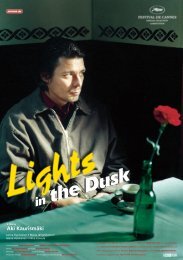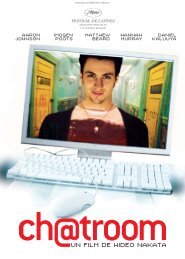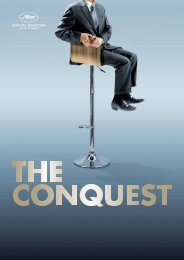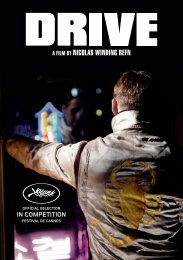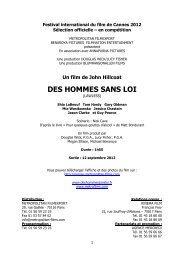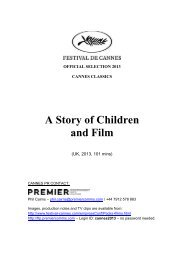IL GATTOPARDO (1963) THE LEOPARD - The Film Foundation
IL GATTOPARDO (1963) THE LEOPARD - The Film Foundation
IL GATTOPARDO (1963) THE LEOPARD - The Film Foundation
You also want an ePaper? Increase the reach of your titles
YUMPU automatically turns print PDFs into web optimized ePapers that Google loves.
<strong>IL</strong> <strong>GATTOPARDO</strong> (<strong>1963</strong>)<br />
<strong>THE</strong> <strong>LEOPARD</strong><br />
Directed by<br />
Luchino Visconti<br />
CAST<br />
DON FABRIZIO CORBERA, PRINCE OF SALINA Burt Lancaster<br />
ANGELICA SEDÀRA Claudia Cardinale<br />
TANCREDI FALCONERI Alain Delon<br />
DON CALÓGERO SEDÀRA Paolo Stoppa<br />
MARIA STELLA CORBERA, PRINCESS OF SALINA Rina Morelli<br />
FA<strong>THE</strong>R PIRRONE Romolo Valli<br />
COUNT CAVRIAGHI Mario Girotti<br />
FRANCESCO PAOLO CORBERA Pierre Clementi<br />
CONCETTA CORBERA Lucilla Morlacchi<br />
CAVALIERE CHEVELLEY Leslie French<br />
DON CICCIO TUMEO Serge Reggiani<br />
CREDITS<br />
DIRECTOR Luchino Visconti<br />
SCREENPLAY Suso Cecchi D’Amico, Enrico Medioli,<br />
Pasquale Festa Campanile, Massimo Franciosa<br />
and Luchino Visconti<br />
FROM <strong>THE</strong> NOVEL BY Giuseppe Tomasi di Lampedusa<br />
DIRECTOR OF PHOTOGRAPHY Giuseppe Rotunno<br />
EDITING Mario Serandrei<br />
MUSIC Nino Rota<br />
MUSICAL <strong>THE</strong>ME Inedit valzer by Giuseppe Verdi<br />
ART DIRECTION Mario Garbuglia<br />
COSTUMES Piero Tosi<br />
SET DECORATION Laudomia Hercolani, Giorgio Pes
<strong>IL</strong> <strong>GATTOPARDO</strong> RESTAURATO: UN’ESPERIENZA SENSORIALE<br />
<strong>IL</strong> <strong>GATTOPARDO</strong> RESTORED: A SENSORY EXPERIENCE<br />
In 1957, shortly after the death of Giuseppe Tomasi di Lampedusa, Il Gattopardo, one of the most amazing literary works of the twentieth century<br />
was published. Il Gattopardo was the only novel to have been written by the author, a Palermo nobleman who drew inspiration from his own family<br />
history in recounting the story of the life of the Prince of Salina. <strong>The</strong> Milanese director Luchino Visconti, himself a descendent of one of the most<br />
important families of Italian nobility, which had founded much of Milan’s greatness, fell in love with the novel and accepted producer Goffredo<br />
Lombardo’s offer to shoot a film that would remain faithful to the book’s spirit. Visconti, who was dealing with a world that he knew intimately<br />
down to the finest detail, did not hold back in his reconstruction: he became the prince of the set during the shoot. Even Lombardo had difficulties<br />
in approving the locations in which he was to shoot!<br />
All the excesses depicted on film were entirely genuine. For the dance scene, boxes of freshly cut flowers were sent from Sanremo daily; the real<br />
candles in the chandeliers were changed hourly; and gold and silver plated tableware, which had been lent by the nobility of Palermo, was used.<br />
For the battle scenes, every extra chosen by Visconti came from a different region of Italy depending on the constitution of the armies (Garibaldi’s<br />
Redshirts, Savoy, Bourbon) which were doing battle; hundreds of Garibaldian jackets were faded one at a time by Piero Tosi using tea leaves.<br />
<strong>The</strong> resulting film is a richly tactile work which captivates all the senses. No other film recreates so thoroughly the atmosphere of the nineteenth<br />
century: not only the interiors and their fittings, but also the time of day, the light, the colours, the Sicilian half-light, the scorching heat, the search<br />
for coolness, the dust that covers the nobles as they make their way up to Castle Donnafugata, the cloth used, the interiors of the coaches,<br />
the clergyman’s filthy cloak, the furniture and every single frame of the ball sequence which in itself accounts for one third of the film and which<br />
seems to never want to end - just as this world that Visconti portrays for the last time, on the verge of disappearing, and in search of lost time<br />
in the most Proustian film ever to be shot. For this miracle to be accomplished a team of outstanding talents was assembled, veterans seasoned<br />
by a thousand Viscontian battles: the scenographer Mario Garbuglia, costume designer Piero Tosi, set designers Giorgio Pes and Princess Laudomia<br />
Hercolani, as well as numerous Palermo aristocrats who not only played themselves in the dance sequence but also lent Visconti much of<br />
the mise-en-scène. Il Gattopardo is the work in which Visconti challenges the impossible, choosing to recreate entirely realistically events which<br />
had taken place one hundred years earlier; his achievement is so perfect that it appears as though the many echoes of nineteenth century painting<br />
in the film (Delacroix and Fattori for the battles, Manet, Monet and the Macchiaioli artists for the representations of nineteenth century life, Signorini<br />
for the glimpses of urban life and bleak houses, Hayez and Boldini for the portraits) have not been cited, but rather it seems almost as if those very<br />
painters had been inspired by the representations of reality that we now see depicted on the screen. <strong>The</strong> paintings hung on the walls of the houses<br />
take part in a live dialogue with the protagonists and the Prince of Salina. During a break in the dancing, while contemplating a copy of Jean-Baptiste<br />
Greuze’s most famous painting, <strong>The</strong> Punished Son, which is called Death of the Just Man in the novel, the Prince of Salina invokes death for<br />
the first time and probably imagines the young Tancredi’s next departure.<br />
Tomasi di Lampedusa’s choral fresco which describes the nobles, the bourgeoisie and the poor with compassion, comes to life in Visconti’s<br />
excessively imagined film shot in Technirama - a format that utilises a frame size twice that of 35mm film, thus giving a more defined image:<br />
it has a visual beauty that is stunning, almost three dimensional. In the Sicilian sun, and under the masterful lighting of Giuseppe Rotunno,<br />
the protagonists and supporting players make up a surprising cast, a cast in which American, French and Italian actors from various artistic traditions<br />
and generations co-exist, whilst all at the height of their fame. <strong>The</strong> sensual, magnetic Claudia Cardinale said, “Visconti trained me how to be<br />
beautiful... I had a glance that was too vague and too quick: he made me define my look, to keep my eyes posed, to hold my gaze... He sculpted<br />
my eyes.” Alain Delon graces the film’s scenes and history with his manner (suited to the March on Rome): he is young, charming, and the first<br />
to understand what is necessary for the safety - albeit temporary - of his world, but his vacuity turns him into prey, destined - in a not too distant<br />
future - to be overwhelmed. Burt Lancaster, who was born in Harlem of Irish descent, left behind his Hollywood stardom to embody the last<br />
Gattopardo, with elegant authoritativeness and intimate emotion. Other players were favourites of Visconti’s: Romolo Valli, a perfect Father Pirrone,<br />
a master of the ambiguous speech; Rina Morelli, the impossible alter ego of her husband, the Prince of Salina; Paolo Stoppa, the odious parvenu<br />
Don Calogero Sedara, who symbolises the new wealthy middle class: active in politics, devoid of any greatness, out of place at the ball where they<br />
awkwardly wear hired dress-coats.<br />
A wonderful example of the creative folly of the Italian cinema director: apart from Visconti’s three “theatre” actors (Stoppa, Morelli and Valli), none<br />
of them recited with their own voice, not even Claudia Cardinale or Terence Hill.<br />
<strong>The</strong> film was attacked by the left-wing due to the aristocratic world’s participation in its making and by the right-wing for its critical attack of the<br />
Italian bourgeoisie. <strong>The</strong> Cardinal of Palermo, Ernesto Ruffini, declared in 1964 that the three “things” that had contributed to the shaming of Sicily were:<br />
the Mafia, Danilo Dolci and Il Gattopardo. <strong>The</strong> film was awarded the Palme D’Or at Cannes and became Visconti’s most popular film.<br />
La Dolce Vita and Il Gattopardo are so different and yet so similar: one film was shot just three years after the other and both of them belong to that<br />
same glorious era of the Italian cinema in which producers, such as Rizzoli, Amato and Lombardo (and one could also include Grimaldi, Cristaldi and<br />
De Laurentiis, amongst others), dared to work with an ambitious cinema of directorial auteurship, a costly cinema with the ability to experiment<br />
with new forms of cinematic language. <strong>The</strong>y produced these films without financial constraints and so found partners for their adventures, above<br />
all in France (both films were co-produced by Pathé).<br />
Both films begin with strongly symbolic sequences. <strong>The</strong> arrival of the helicopter transporting the statue of Christ that flies overhead, followed by<br />
the paparazzi sequence: classical Rome, but also the Rome of cement that devours new neighbourhoods and the Rome of the new social classes<br />
that were emerging at that time. <strong>The</strong> achingly beautiful Palazzo Salina (in reality Villa Boscogrande) in the Sicilian sun on a late afternoon in May,<br />
immersed in the rich green citrus orchard, its gate and its never changing statues. Inside, the noble Salina family and Prince Don Fabrizio are praying,<br />
but voices, insistent and annoying, intrude from outside. History is knocking at the door of this ancient family. Garibaldi’s men are at the gates<br />
of Palermo, in the orchard there lies the body of a dead Bourbon soldier. Visconti winds the clock back six years from the events that he depicted<br />
in Senso. But even here he recounts a betrayed and missed revolution. In the film’s three hours many things occur, but nothing seemingly appears<br />
to happen. <strong>The</strong>re isn’t the rout of the Italian army at Custoza and the treachery of Alida Valli / Livia Serpieri like in Senso, but there is the defeat<br />
of the ideals of the Risorgimento, the “faked” ballot results and the inability of the new state to understand and rectify the injustices which hold<br />
a vice-like grip over Sicily. In his first scene, Delon / Tancredi’s reflection appears in the mirror where Lancaster / the Prince of Salina is shaving<br />
himself: in that precise moment they seem to display a single identity. He says in that first conversation, “If we want things to stay the same,<br />
everything must change.” <strong>The</strong> Prince states one hour later, “Surely some small thing had to change, so that everything could remain the same.”<br />
If La Dolce Vita talks about a society changing, undergoing a deep transformation, Il Gattopardo talks about a class that is able to stand still,<br />
to survive, immutable, even after the fall of their reign.<br />
Il Gattopardo, like La Dolce Vita, changed the way in which cinema was to be conceived: signaling a watershed for filmmakers begun by Visconti<br />
and Fellini. If La Dolce Vita highlighted the mise-en-scène and the mediatisation of reality for the first time, Il Gattopardo brought to the screen,<br />
as never before, the past, the roots of a people and their history. From Il Gattopardo onwards, no historical film, battle scene, scenes of balls or<br />
opulence could not but be measured against that model of perfection.<br />
For Visconti it signaled the beginning of a new phase, towards an even more intimate and personal cinema.<br />
Gian Luca Farinelli<br />
Cineteca di Bologna
<strong>THE</strong> <strong>LEOPARD</strong><br />
When the world around you is changing, when you have the sense that everything you know and love must give way to a new order, what do you<br />
do? Fight it? Accept it? And how do you accept it? Grudgingly? Gracefully? Maybe something in between. Because who can leave the world that<br />
formed them behind, and not mourn the passing of time? <strong>The</strong>se questions, these sensations, are fundamental to the human condition, and they are<br />
behind every frame of <strong>The</strong> Leopard, Luchino Visconti’s magnificent adaptation of Giuseppe di Lampedusa’s novel about a Sicilian prince at the time<br />
of the Risorgimento (the unification) who recognizes that his historical role, and that of his entire class, is to retreat into the shadows.<br />
Visconti, who was himself from one of the oldest aristocratic families in Europe, spent many years trying to adapt Proust to the screen. In a sense<br />
he succeeded with this stunning cinematic tapestry, in which every gesture, every word, and the arrangement of every object in every room<br />
summons a lost world back to life.<br />
<strong>The</strong> Leopard is an epic of time, and its slowness, which reaches a stately crescendo during the extended, climactic grand ball sequence, is set<br />
by the rhythm of life among the landed aristocrats of Sicily - their customs and habits, their observance of leisure and reflection, their seasonal<br />
journeys. It is also an epic of history, in which we actually see the machinations of change in progress, on the battlefield, in the streets, and in<br />
the drawing rooms where men of influence gather to decide who will pull the levers of power. It is also a portrait of one man, the Prince of Salina,<br />
played by Burt Lancaster. At the time the picture was made, there were some people who questioned this particular casting choice, but once<br />
you’ve seen <strong>The</strong> Leopard it becomes impossible to imagine anyone else as the Prince. Lancaster brought his strength and authority to the role,<br />
but he also brought his intelligence and his grace, and his sense of aristocratic refinement is uncanny. A remarkable, deeply moving performance.<br />
Finally, <strong>The</strong> Leopard is a grand symphonic hymn to Sicily itself - the people, the perfumed air and the landscape, its beauty and its violence.<br />
Visconti’s film is one of the greatest visual experiences in cinema, and over the years restorations have proven to be extremely difficult. I’m very<br />
pleased that <strong>The</strong> <strong>Film</strong> <strong>Foundation</strong>, with financial support from Gucci, has helped to make this extraordinary restoration possible. One of our<br />
greatest treasures has returned to us, in its full glory.<br />
Martin Scorsese<br />
Founder and Chair, <strong>The</strong> <strong>Film</strong> <strong>Foundation</strong><br />
ABOUT <strong>THE</strong> RESTORATION<br />
“In order for everything to stay the same, everything must change.” Although Tancredi (Alain Delon) is speaking about the future of Italian<br />
aristocracy, his description is an apt one for film restoration as well. Motion picture technology has changed radically over time, and a primary<br />
challenge of restoration is the attempt to recreate the impossible experience of seeing the film as it was originally presented. Today, powerful<br />
digital tools allow us almost unlimited freedom in image manipulation and color correction - to almost entirely erase the ravages of time and<br />
more closely represent the original artistic and technical achievements of Il Gattopardo than was previously possible using traditional<br />
photochemical techniques.<br />
Il Gattopardo was photographed in a process called Technirama, in which images were captured on 35mm film horizontally rather than vertically.<br />
<strong>The</strong> resulting anamorphic image, twice the size of a standard 35mm frame, is remarkably sharp and full of detail. Since <strong>1963</strong>, the camera negative<br />
has now faded, and exhibits most of the issues common to films of its era - although interestingly, because of the photographic process, scratches<br />
and dirt move horizontally across the frame rather than vertically.<br />
For this new restoration, the original Technirama camera negatives were scanned at 8K (8000 lines of horizontal resolution), resulting in twenty-one<br />
terabytes of data. A 35mm protection interpositive was also scanned for sections needed to replace material not present in the original camera<br />
negatives. After scanning, all files were converted to 4K, and the balance of picture restoration was performed entirely digitally at this resolution.<br />
Over 12,000 hours of manual restoration was performed, removing forty-seven years’ worth of dirt, scratches, and other physical anomalies.<br />
<strong>The</strong> original monaural soundtrack has also been carefully restored, using a 35mm magnetic source which was digitally captured and processed<br />
to remove distracting pops, clicks, and noise while still faithfully representing the characteristics of the original presentation.<br />
<strong>The</strong> restoration of Il Gattopardo is presented both in a 4K digital cinema package as well as in traditional 35mm film prints. Archival film elements<br />
and data archives have been created of both the restored and unrestored versions of the film in order to preserve Il Gattopardo for generations<br />
to come.<br />
Schawn Belston<br />
<strong>Film</strong> Preservation, Twentieth Century Fox
GUCCI: FOREVER NOW<br />
Celebrating a rich history influenced by film, Gucci has made a long-term commitment to support <strong>The</strong> <strong>Film</strong> <strong>Foundation</strong>’s efforts to save cinematic<br />
treasures. Many are not aware that these valuable artifacts of our cultural heritage are in danger of deterioration. Those who work to preserve<br />
the films of the first hundred years of cinema are in a race against time.<br />
<strong>The</strong>re is no more powerful way to make clear the preservation message than to provide audiences with the opportunity to experience restored<br />
cinematic masterpieces firsthand. Gucci is proud to partner with <strong>The</strong> <strong>Film</strong> <strong>Foundation</strong> to restore and present the works of visionary filmmakers like<br />
Luchino Visconti, who have made an enduring contribution to the history of motion pictures.<br />
Inspired by its heritage as an iconic brand, Gucci celebrates the creativity of the past as inspiration for the future. It is the hallmark of the company’s<br />
‘Forever Now’ philosophy - and the foundation for Gucci’s commitment to preserving the work of artists and their legacies.<br />
<strong>The</strong> restoration of Il Gattopardo has been made possible by Gucci as part of a multi-year partnership with <strong>The</strong> <strong>Film</strong> <strong>Foundation</strong> to add at least<br />
one film every year to a growing collection of restored titles that includes A Woman Under <strong>The</strong> Influence (1974, d. John Cassavetes), Le Amiche<br />
(1955, d. Michelangelo Antonioni), Wanda (1970, d. Barbara Loden), Senso (1954, d. Luchino Visconti), Il Gattopardo (<strong>1963</strong>, d. Luchino Visconti)<br />
and La Dolce Vita (1960, d. Federico Fellini).<br />
Gucci salutes Martin Scorsese, <strong>The</strong> <strong>Film</strong> <strong>Foundation</strong> and its partner archives for ensuring that these films will survive to be seen and experienced<br />
by future generations.<br />
<strong>THE</strong> F<strong>IL</strong>M FOUNDATION<br />
For twenty years, <strong>The</strong> <strong>Film</strong> <strong>Foundation</strong> (film-foundation.org), a nonprofit organization established in 1990 by Martin Scorsese, has been dedicated<br />
to protecting and preserving motion picture history, by providing substantial annual support for preservation and restoration projects at major film<br />
archives. Since its inception, the foundation has raised awareness of the urgent need to preserve films and has helped save nearly 545 films. Joining<br />
Scorsese on the board of directors are Woody Allen, Paul Thomas Anderson, Wes Anderson, Francis Ford Coppola, Clint Eastwood, Curtis Hanson,<br />
Peter Jackson, Ang Lee, George Lucas, Alexander Payne, Robert Redford and Steven Spielberg. <strong>The</strong> <strong>Film</strong> <strong>Foundation</strong> is aligned with the Directors<br />
Guild of America whose President and Secretary-Treasurer serve on the foundation’s board.<br />
TWENTIETH CENTURY FOX<br />
Through its <strong>Film</strong> Preservation department, Twentieth Century Fox has established its dedication to the conservation of our film heritage through the<br />
restoration and preservation of over 1,000 feature films since 1997. In 2006, with the support of Jim Gianopulos, Chairman of Fox <strong>Film</strong>ed Entertainment,<br />
Fox began a new collaboration with <strong>The</strong> <strong>Film</strong> <strong>Foundation</strong>, working with the foundation and its member archives to restore classic Fox films. Since<br />
the partnership’s beginning, the two organizations have also worked with the Academy <strong>Film</strong> Archive on the digital restorations of four other titles:<br />
Drums Along <strong>The</strong> Mohawk (1939, d. John Ford), Leave Her To Heaven (1945, d. John M. Stahl), <strong>The</strong> Robe (1953, d. Henry Koster), and Wild River<br />
(1960, d. Elia Kazan), which premiered at the TCM Classic <strong>Film</strong> Festival in April 2010 in Los Angeles.<br />
JÉRÔME SEYDOUX-PATHÉ FOUNDATION<br />
Founded in 2006, the Jérôme Seydoux-Pathé <strong>Foundation</strong> is a research center for film history, and more particularly on Pathé. <strong>The</strong> <strong>Foundation</strong><br />
works to safeguard and promote the important collection Pathé has built since its creation in 1896, such as original film posters, photographs,<br />
materials, scenarios, catalogues, mail exchanges, and administrative documents. <strong>The</strong> archive for <strong>The</strong> Leopard, co-produced and distributed by<br />
Pathé, includes more than 1,000 negatives that offer precious testimonies of the history of the shooting and the various scenes. <strong>The</strong> entire<br />
collection has been organized in seven albums, allowing Pathé to generate several sets of photographs for external use and press purposes.<br />
Given their unique elements and inspirational value, the albums are one of the Jérôme Seydoux-Pathé <strong>Foundation</strong>’s jewels. <strong>The</strong> <strong>Foundation</strong><br />
also holds and conserves a significant amount of posters and documents from this important film.
CINETECA DI BOLOGNA<br />
Cineteca di Bologna is an internationally distinguished film archive, founded in the 1960s, a full member of the Fédération Internationale<br />
des Archives du <strong>Film</strong> (FIAF) since 1989 and of the Association des Cinémathèques Européennes (ACE). In the last 15 years Cineteca di Bologna<br />
has broadened its projects, activities and areas of distinction which include: film restoration, film collection, teaching programs, daily theatrical<br />
screenings, publishing (books and DVDs), a globally known restoration festival - Il Cinema Ritrovato - and five other festivals throughout the year,<br />
a library, non-film collections - photography, graphic design, art, and archives - the Chaplin, Pasolini, Blasetti, Renzi, Olmi archives.<br />
Cineteca di Bologna film vaults hold a collection of over 35,000 prints including 16 and 35mm, positives and negatives of films restored by Cineteca<br />
di Bologna, and collections belonging to film producers, distributors and film collectors, offering a representation of the whole history of cinema, from<br />
silent to sound up to the 1990s. Among others, the legendary film production company Titanus has recently deposited its collection with the Cineteca.<br />
Cineteca’s L’Immagine Ritrovata laboratory has established its reputation in the world of film archives thanks to the restoration of many<br />
masterpieces by Leone, Chaplin, Pasolini, the Lumière brothers, Visconti, Murnau, Renoir and many others. Cineteca has collaborated with<br />
<strong>The</strong> <strong>Film</strong> <strong>Foundation</strong> in the past and is a partner in Martin Scorsese’s non-profit World Cinema <strong>Foundation</strong> for the restoration, the dissemination and<br />
the preservation of cinema heritage from neglected countries.<br />
CENTRO SPERIMENTALE CINEMATOGRAFIA / CINETECA NAZIONALE<br />
<strong>The</strong> Cineteca Nazionale - one of the two sections of Centro Sperimentale di Cinematografia, with the Scuola Nazionale di Cinema - is one of<br />
the most important film archives in Europe, boasting over 80,000 copies including the patrimony of the Archivio Nazionale del Cinema d’Impresa<br />
in Ivrea. Established by a state law of 1949, the Cineteca Nazionale has the task of conserving the Italian film heritage. Alongside the conservation<br />
of this precious patrimony, the Cineteca Nazionale carries out an intense activity of restoration and distribution.<br />
COLORWORKS<br />
Colorworks, a Sony Pictures Technologies company, operates the state-of-the-art digital post production and restoration facilities for the<br />
entertainment industry. Located at the Sony Pictures Studio in Culver City, California, Colorworks has worked on some of today’s and yesterday’s<br />
most important motion pictures. <strong>The</strong> center provides services such as 2-D and 3-D digital intermediate, digital film scanning, color correction,<br />
restoration and film recording, among others. Colorworks is becoming a leader in the field of film restoration and digital intermediate by developing<br />
new technology and workflows that are revolutionizing the restoration and post production industry. Colorworks’ team of award-winning artists<br />
and technicians is what drives its innovation and creativity.<br />
RESTORATION CREDITS<br />
<strong>IL</strong> <strong>GATTOPARDO</strong> HAS BEEN RESTORED IN ASSOCIATION<br />
WITH CINETECA DI BOLOGNA, L’IMMAGINE RITROVATA,<br />
<strong>THE</strong> F<strong>IL</strong>M FOUNDATION, PATHÉ, FONDATION JÉRÔME SEYDOUX-PATHÉ,<br />
TWENTIETH CENTURY FOX AND CENTRO SPERIMENTALE<br />
DI CINEMATOGRAFIA-CINETECA NAZIONALE<br />
RESTORATION FUNDING PROVIDED BY GUCCI AND <strong>THE</strong> F<strong>IL</strong>M FOUNDATION<br />
DIGITAL PICTURE RESTORATION: COLORWORKS<br />
SOUND LABORATORY SERVICES: L’IMMAGINE RITROVATA<br />
SPECIAL THANKS<br />
GIUSEPPE ROTUNNO<br />
MARTIN SCORSESE<br />
TITANUS<br />
PHOTO CREDITS<br />
Photos and images provided by Angelo Cesselon, Cineteca di Bologna,<br />
Collection Fondation Jérôme Seydoux-Pathé ©<strong>1963</strong> Pathé Production-Titanus,<br />
G.B. Poletto, Reporters Associati-Roma, Martin Scorsese, Piero Tosi,<br />
and Twentieth Century Fox<br />
Photos and images by permission of Pathé and Twentieth Century Fox




